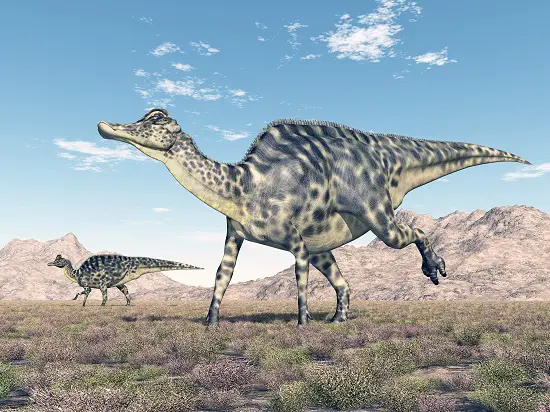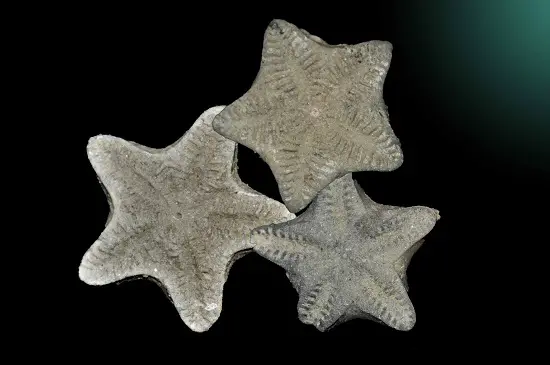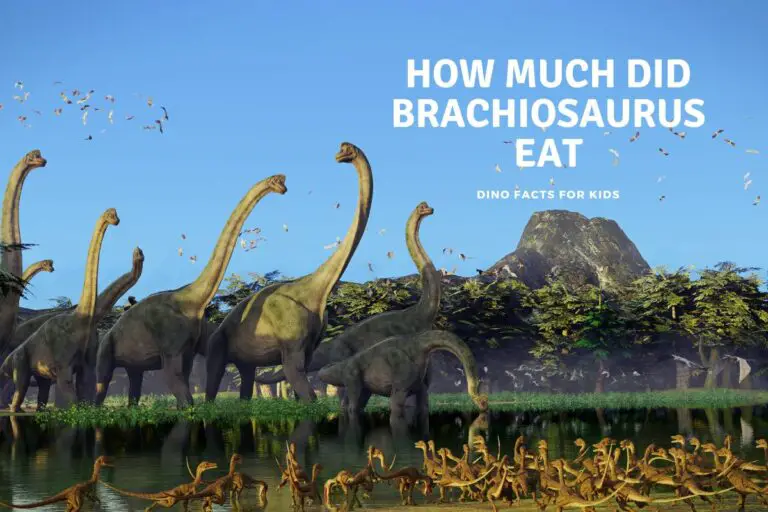What is the State Dinosaur of Missouri?
Missouri’s state dinosaur was a toothy one with over 1000 serrated small teeth, luckily it was a herbivore as a carnivore with that many teeth doesn’t bear thinking about! Like most state dinosaurs it was a resident of the state it become the dinosaur symbol of. The state dinosaur of missouri was a hadrosaur like New jerseys dinosaur. We take a look at it in more detail below.
The state dinosaur of Missouri is the Parrosaurus missouriensis. It was previously known as hypsibema. Parrosaurus was a type of hadrosaur that lived around 75 million years ago in what is now the Missouri. Its scientific name, Missouriensis, represents this and it is where its fossil remains have been found.
Like a few other dinosaurs its name has gone through a bit of a journey. It was originally named Neosaurus missouriensis, then renamed Parrosaurus missouriensis and then, Hypsibema missouriensis.
As of 2018 it has once again reverted to Parrosaurus and this is likely to be reflected in 2023 in the name of the State dinosaur as well once an amendment passes though the state legislature.
However despite this identity crisis you may notice that the Missouri part of its name has remained a constant. It was and is a Missouri dinosaur though and through.

Parrosaurus: The State Dinosaur of Missouri
We have some quick facts about the Missouri State dinosaur, the Parrosaurus below for you and have included the most important of these in a table to make access easier as well.
Parrosaurus Quick Facts
Despite all the name changes, and even being mistaken for a sauropod when it was first discovered in 1942, Parrosaurus is a hadrosaur type dinosaur. Similar in appearance to other hadrosaurs, although on the large size of the family.
It lived in what is now Missouri towards the end of the age of the dinosaurs around 75 million years ago and was the first discovery of dinosaur fossils in Missouri. We take a look at some facts about Missouri’s state dinosaur below.
Here are some facts about the Parrosaurus missouriense:
- Parrosaurus was a large, herbivorous dinosaur that lived during the Late Cretaceous period, around 75 million years ago.
- It was a member of the Hadrosauridae family, which includes other well-known dinosaurs such as the parasaurolophus, and corythosaurus.
- It was characterized by its long, duck-like bill and the presence of bony crests on its head.
- It probably lived in herds and used its bill to graze on plants and foliage.
- It was native to what is now the United States, and its fossil remains have been found in several states, including Missouri, Oklahoma, and Texas.
- It was named the State dinosaur of Missouri in 1994.
- It was a relatively common dinosaur and is known from a number of well-preserved fossil specimens.
- Parrosaurus was a close relative of the Corythosaurus, another well-known hadrosaur.
- Its previous scientific name is Hypsibema missouriense, with “Hypsibema” meaning “high crest” and “missouriense” referring to the state of Missouri.
- Hypsibema is pronounced with 4 syllables, and can be said like this. Hip – Sih – Bee – Mah while Parrosaurus, the name it is currently known by, is pronounced Pah – Row – Saw – Rus
| Dinosaur Name | State Dinosaur of | Length | Height | Weight | When Lived | When and where Discovered |
| Parrosaurus | Missouri, 2004 | 30 -35 feet (9-11 metres) | 10 feet (3 metres) | up to 6500, 8800 lbs (3-4,000 kg) | 113-110 million years ago | Oklahoma, 1940-50 |
Why is Parrosaurus the State Dinosaur of Missouri?
Although the original bill to adopt Missouri’s state dinosaur was introduced in January 2004, it was for the more generic hadrosaur. This encompasses many different species of dinosaurs and needed to be more specific.
Parrosaurus (then Hypsibema ) was then suggested and the vote was put to the Missouri house of representatives on the 8th of March, 2004. The vote was almost unanimous (147-4) in favour and then the senate voted 34 – 0 to adopt the Hypsibema (now Parrosaurus) as the state dinosaur of Missouri.

The bill was signed on July the 9th, and then on August 28th, 2004 Missouri had its own State dinosaur! It made Missouri the sixth state to have a dinosaur as a state symbol.
As an incentive to other states it is worth noting that museums in the area recorded a tripling of visitors when the state dinosaur was adopted, including from all over the United States.
Where was Parrosaurus discovered?
The Parrosaurus missouriensis was first discovered in 1942 while a local family were digging a cistern (well) to collect water in Bollinger Country, Missouri. Dan Stewart (Dinosaur Dan) was made aware of the find and the remains were bought for 50 dollars ( which was then used to buy a cow!)

The were later found, at the original dig site, to share their fossil bed with fossils of fish, turtles, plants and even teeth from large predators.
Although found in 1942 it took until the 1980’s to firmly establish that Parrosaurus was a hadrosaur rather than a sauropod. Further remains we found in 2011 and again in 2016 and 2017.
What is the State Fossil of Missouri?
The state fossil of Missouri is the crinoid, or sea lily. Crinoids were marine animals that lived during the Paleozoic era, about 300 million years ago. They are characterized by their long, slender stems and circular plates, which were used for feeding and protection. Fossilized crinoids are found in a variety of rock formations around the world, including in Missouri. They were named the state fossil of Missouri in 1989.
Eperisocrinus was a genus of crinoids, or sea lilies, that lived during the Middle Ordovician period, around 450 million years ago. Crinoids were marine animals that were characterized by their long, slender stems and circular plates, which were used for feeding and protection.
Eperisocrinus was a type of “discomedusan” crinoid, which means that it had a stem but no arms. It is known from fossilized remains that have been found in North America and Europe. Some interesting facts about Eperisocrinus include:
- It was a small crinoid, with a stem that was typically less than 10 cm (4 inches) long.
- It had a simple, cup-shaped body, with a single central mouth surrounded by a ring of tentacles.
- It lived in shallow, warm water environments and probably fed on small particles of organic matter that it filtered from the water using its tentacles.
- Its fossilized remains are found in rocks that formed in shallow seas, indicating that it lived near the coast.
- It is classified as a “discomedusan” crinoid, meaning that it had a stem but no arms. This is in contrast to other types of crinoids, which had both stems and arms.
- It is an important part of the fossil record and has been used to help understand the evolution and diversity of crinoids during the Paleozoic era

you can check out the other state dinosaurs, those that have adopted one as a state symbol, here in the following list.
- Arizona
- Arkansas
- California
- Colorado
- Connecticut
- Delaware
- District of Columbia
- Massachusetts
- Maryland
- Missouri
- New Jersey
- Oklahoma
- Texas
- Utah
- Wyoming
You can also read more about State dinosaurs in our US State dinosaur page as well linked here and below.
Conclusion
The name of this dinosaur seems to be ever changing! Although most commonly known as Hypsibema it has once again reverted to Parrosaurus, and although the state has not changed this back yet it is currently under review and will be voted through shortly.
So the Parrosaurus missouriense is once again the state dinosaur of Missouri and hopefully this time the name sticks!
References
- https://en.wikipedia.org/wiki/Hypsibema_missouriensis#Discovery_and_History
- https://dnr.mo.gov/document-search/crinoid-missouris-official-state-fossil-pub0660/pub0660
- https://www.sos.mo.gov/symbol/dinosaur#:~:text=Gilmore%20named%20the%20Missouri%20specimen,then%20Hypsibema%20missouriensis%20in%201979.
- https://edition.cnn.com/2021/11/24/world/missouri-dinosaur-bones-uncovered-scn/index.html
- https://www.columbiamissourian.com/news/house-approves-updated-name-for-missouri-state-dinosaur/article_fe71d262-bb6a-11ec-a0cf-432f52a77670.html
Hi, I am Roy Ford a General Studies and English Teacher who has taught all over the world. What started as a fossil collection became a great way to teach, motivate and inspire students of all ages and all over the world about dinosaurs and from that and children’s love of dinosaurs came the site dinosaur facts for kids, a resource for all ages.






